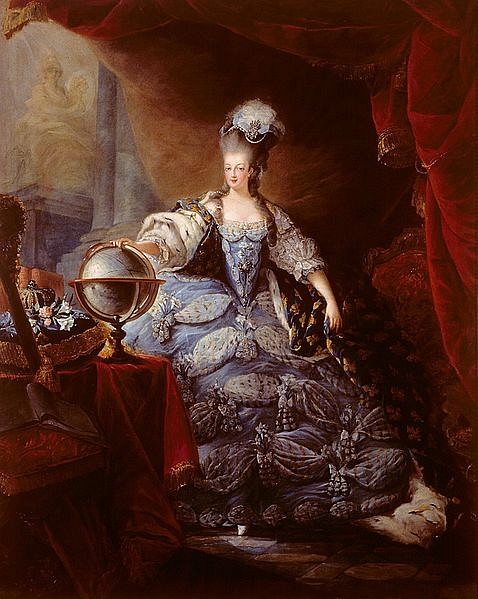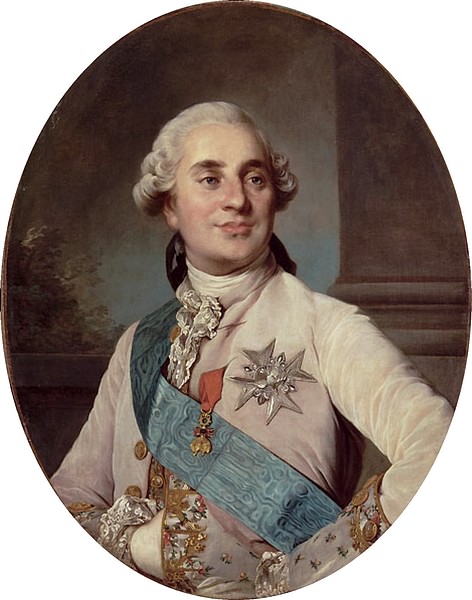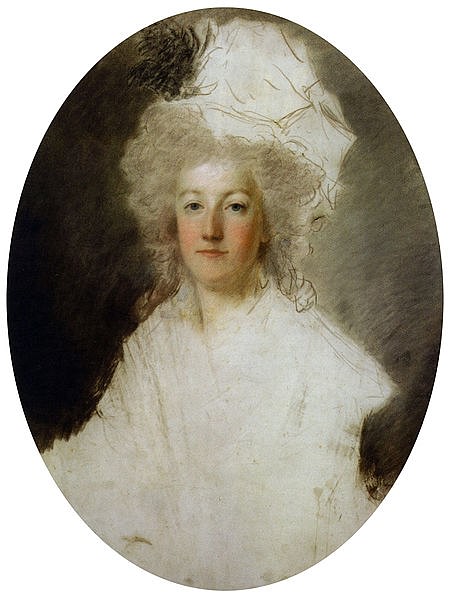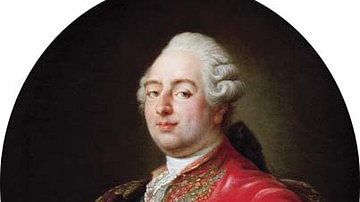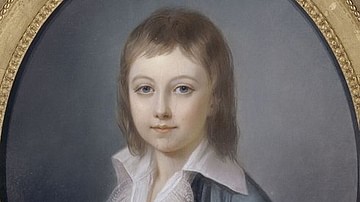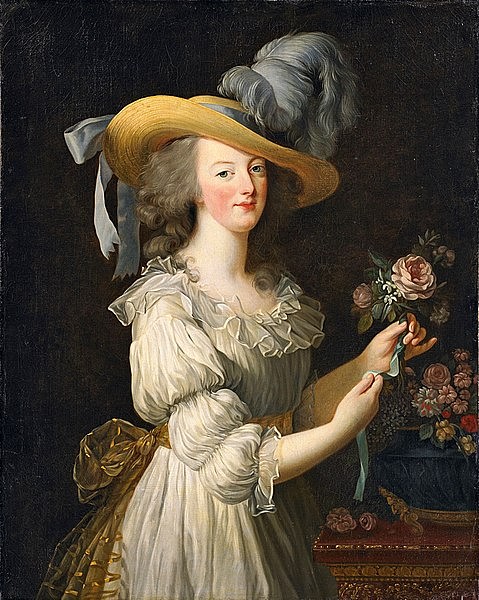
Marie Antoinette (l. 1755-1793) was the queen of France during the turbulent final years of the Ancien Régime and the subsequent French Revolution (1789-1799). With the ascension of her husband Louis XVI of France (r. 1774-1792), she became queen at the age of 18 and would shoulder much of the blame for the perceived moral failures of the French monarchy.
Early Life
She was born in Vienna on 2 November 1755 as Maria Antonia Josepha Joanna, archduchess of Austria. Her birthdate was an inauspicious one, coming as it did a day after a great earthquake killed 30,000 people in Lisbon, a chilling portent of her unlucky future. But her parents, the Habsburg Empress Maria Theresa of Austria (l. 1717-1780) and Francis I, Holy Roman Emperor (l. 1708-1765), were at the zenith of their own glory and saw no reason not to celebrate the birth of their fifteenth and penultimate child, the future queen of France.
The young archduchess, affectionately nicknamed 'Madame Antoine' by her mother, enjoyed a happy childhood, spending her winters sledding down the hills near the family lodge at Laxenburg and her summers in the comforts of Schönbrunn Palace in Vienna. It was at Schönbrunn where Maria Antonia met child prodigy Wolfgang Amadeus Mozart when they were both seven and where she would take up her own interest in music, playing both harpsichord and flute, and excelling in the art of dancing. In a family so large, Maria Antonia found comfort in the friendship of her sister, Maria Carolina, future queen of Naples and Sicily.
Maria Theresa was never the warmest of mothers, but the death of her husband in 1765 would send the empress into a state of grieving that would last the rest of her life, often taking the form of dissatisfaction with the behavior of her youngest children. This distant and complex relationship with Maria Antonia, who was as much a political pawn as she was a daughter, could best be summed up in the later words of an adult Marie Antoinette, "I love the Empress, but I'm frightened of her, even at a distance; when I'm writing to her, I never feel completely at ease" (Fraser, 22). However, for a family as significant as the Habsburgs, duty would always come before filial love, and so Maria Antonia found herself betrothed to the dauphin of France in 1769.
A Franco-Austrian alliance was certainly a controversial development, as many people in each country hated the other; prior to the Seven Years' War (1756-1763), King Louis XV of France (r. 1715-1774) himself had been an enemy of Maria Theresa. Yet following that conflict, the weakened Kingdom of France had begrudgingly entered into an alliance of necessity with Austria, with both nations agreeing that such an alliance should be solidified with a marriage. It was eventually decided that Maria Antonia would be married to Louis XV's grandson, Louis-Auguste, Duke of Berry (l. 1754-1793) who had become heir and dauphin of France upon the death of his father in 1766. So, after a proxy marriage and a renunciation of all claims to Habsburg lands, Maria Antonia set off for France to meet her new husband and arrived in Versailles on 14 May 1770, aged only 14. Along with the title of dauphine, she also adopted the French version of her name: Marie Antoinette.
Dauphine of France
The transition from Austrian archduchess to French dauphine was not an easy one. In addition to Marie Antoinette's lackluster French, peppered haphazardly with German phrases, her assimilation was made difficult by the strict etiquette of courtly life at Versailles. In a court designed specifically to revolve around the royal family, Marie Antoinette found that privacy was not a luxury afforded to French royals. Courtiers watched her as she ate, while an audience of ladies kept her company as she dressed. Meanwhile, she had to become used to the minutiae of courtly protocols and to the fashion of Versailles, which consisted of lavish applications of rouge make-up and hair powder, a combination that fellow Austrian Leopold Mozart described as "unbearable to the eyes of an honest German" (Fraser, 78).
Yet the teenaged dauphine had to assimilate quickly. The empress, who remained in constant correspondence with Marie Antoinette, expected all her children to work to further Habsburg interests. Maria Theresa expected reports on French ministerial appointments and urged her daughter to influence France's foreign policy in favor of Austria. This was often difficult, especially in situations where Austrian interests conflicted with those of France, such as with the First Partition of Poland in 1772 and the War of Bavarian Succession in 1778. Maria Theresa's looming presence did nothing to help the reputation of Marie Antoinette, who was accused of being too loyal to her native land and was often referred to disparagingly as l’Autrichienne (the Austrian).
Despite all this, Marie Antoinette was indeed popular during her first few years in France. Young, beautiful, and charming, her first official visit to Paris in 1773 was a grand success. Her practiced gracefulness endeared her to the ladies of the court, particularly the dauphin's aunts, and she made efforts to connect with her husband as well, accompanying him on his beloved hunts. But she still had rivals, most notably Madame Du Barry, Louis XV's chief royal mistress, whose influence over the aging king made her regent of France in all but name.
The rivalry began when Du Barry caused the dismissal of the Duke of Choiseul, an architect of the Franco-Austrian alliance who Marie Antoinette considered a friend and ally at court. Marie Antoinette refused to speak to Du Barry after that, which could have caused a scandal had Maria Theresa not commanded her daughter to speak to the woman. Marie Antoinette did so begrudgingly. On New Year's Day 1772, she spoke one uninspired sentence to Du Barry: "There are a lot of people at Versailles today" (Fraser, 98). It was not much, but it was enough to avoid a scandal. Marie Antoinette remained hostile toward Du Barry, however, and Du Barry would be exiled from court two days after the ascension of Louis XVI.
Queen of France
On 10 May 1774, Louis XV died of smallpox. Upon his death, 19-year-old Louis-Auguste ascended to the throne as Louis XVI, king of France and Navarre, with Marie Antoinette his queen consort. The coronation was held in Reims just over a year later.
Yet amidst the ceremony of the coronation, there was a major issue with the royal couple's marriage: Marie Antoinette had yet to conceive a child. In fact, by 1777, the royal couple's seven-year marriage had yet to even be consummated. Since producing heirs was an essential role of any queen consort, the longer Marie Antoinette went without bearing children, the less secure her position. The marriages of the king's younger brothers, the counts of Provence and Artois, threatened to undermine her influence if their marriages produced children before hers, a fear that was realized with the birth of Artois' son in 1775. Clearly, the king and queen needed some guidance. Eager to see a half-Habsburg heir to the French throne, Marie Antoinette's eldest brother, Joseph II, Holy Roman Emperor (r. 1765-1790) took it upon himself to save his sister's marriage.
Joseph arrived in France incognito in April 1777. He met with both king and queen, inquiring as to why the marriage had not been consummated. Although Louis XVI was rumored to be suffering from phimosis, a condition that would have made the act of sex painful, Joseph was able to discern that it was more likely an issue of Louis being apathetic to his husbandly duties. In a letter to his brother Leopold, Joseph mockingly described Louis' odd way of lovemaking: "He introduces his member, stays there without moving for about two minutes, withdraws…and bids goodnight" (Fraser, 156). Joseph must have educated his brother-in-law in the correct way to perform the act, for after he returned to Vienna, he received letters from both Louis and Marie Antoinette thanking him for his advice and announcing that the queen was finally pregnant. It seemed that whatever Joseph had said had been successful, as henceforth Louis stopped being "two thirds of a husband" (Fraser, 157).
Marie Antoinette would have four children. The birth of a daughter, Marie-Thérèse, in 1778 would be followed by the long-anticipated birth of a dauphin, Louis-Joseph, in 1781, and another boy, Louis-Charles, in 1785. Her last child, Sophie, was born in 1786 and would live for only 11 months; a disturbing precedent, as only Marie Antoinette's eldest child would live to see adulthood. The queen was a loving mother, who adored each of her children. Marie Antoinette's children also included multiple adoptions.
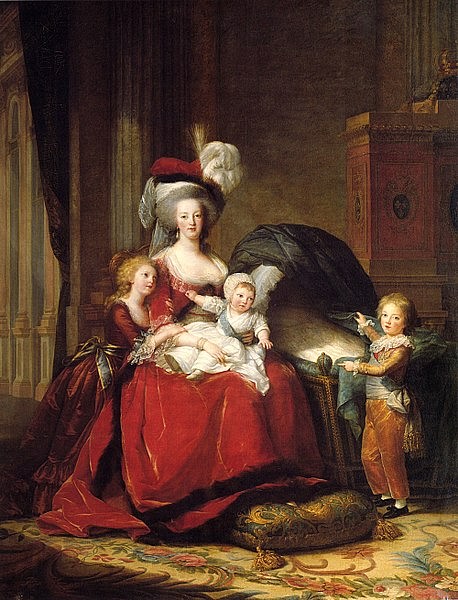
The queen's sudden fertility was looked upon suspiciously by some. The scandalous libelle pamphlets, which had been attacking Marie Antoinette for as long as she had been queen, began spreading rumors that Louis XVI was not the father to the royal children. This was a dangerous thing to be accused of in a government that derived its legitimacy from a valid royal bloodline. Although the queen had been in an affair with the dashing Swedish soldier Count Axel von Fersen (1755-1810) since 1783, many of her biographers, including Antonia Fraser, reject the idea that Marie Antoinette's children were fathered by anyone but the king.
Of course, enemies of the monarchy, and those hoping to make money off the gossip-filled libelles, did not care for the truth. Because she was a foreigner and a woman, Marie Antoinette quickly became a favorite target of slanderous rumor. She was compared to notorious women from history, with one pamphlet calling her "blacker than Agrippina…lewder than Messalina" (Furet, 258). She was accused of multiple acts of sexual deviancy, from holding orgies in the gardens of Versailles to engaging in closeted lesbian romances. The libelles themselves were often pornographic and included images of Marie Antoinette in obscene situations. Except for her relationship with Fersen, these tales of Marie Antoinette's promiscuity were outright fabrications.
The queen was also accused of being a careless spendthrift. She was famous for enjoying games of cards and billiards behind the closed doors of the Petit Trianon, her personal palace given to her by Louis XVI as a wedding gift. Marie Antoinette's gambling, combined with her expenses on fashionable dresses and furniture for her royal apartments, was met with disapproval by many, as the country continued to hurtle toward bankruptcy. Although the queen was hardly the only lavish spender in the royal household, she was still looked upon as a symbol of the crown's wanton spending, earning her the nickname 'Madame Deficit'. Yet it is important to note that Marie Antoinette also frequently donated to charities and engaged in acts of philanthropy.
The affair of the diamond necklace, coming to light in 1785, seemed to be the final nail in the coffin of the queen's already slipping reputation. Although she was an innocent victim in the affair, which involved swindlers using her forged signature to obtain an expensive necklace, Marie Antoinette was still widely blamed for the ensuing scandal. Her spending continued to be scrutinized and exaggerated, with all attempts at repairing her image failing. On the eve of the Revolution, the queen was so despised she stopped appearing at public events.
Fall of the Monarchy
In 1788, the rapidly deteriorating state of French finances forced Louis XVI to schedule a meeting of the Estates-General to be held the following year. In the hopes of winning some much-needed public support preceding the meeting, Marie Antoinette orchestrated the reinstatement of popular financial minister Jacques Necker (1732-1804). Necker's appointment proved to be a short-term victory, as it led to a surge in public approval of the government, as well as an immediate rise in the stock exchange. Yet it was much too late to win back public support; leading the procession of Estates-General deputies on 4 May 1789, Marie Antoinette was greeted by icy silence from the same onlookers who cheered the popular champions of the commoners that followed her.
The queen was present for the opening of the Estates-General, but she was soon called away, as the condition of the sickly dauphin worsened. On 4 June, Louis-Joseph died of tuberculosis, aged only 7. The death of her second child in two years (Sophie had died in 1787) only added to Marie Antoinette's grief as she went into a state of mourning. However, it seemed that the country took little notice, as all eyes were upon the Estates-General, where the Third Estate was forming a National Assembly and clamoring for a new constitution.
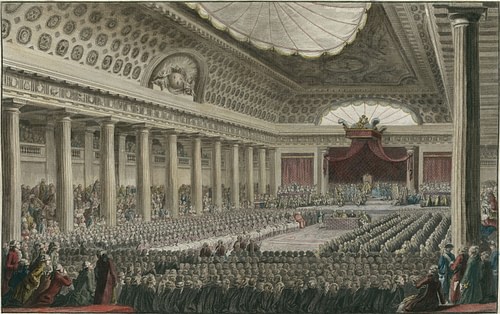
Following the Storming of the Bastille on 14 July 1789, the Assembly passed the August Decrees, which dismantled the system of feudalism, and adopted the Declaration of the Rights of Man and Citizen. As the National Assembly dismembered the Ancien Régime one decree at a time, Louis XVI stubbornly fought to retain his kingly authority. Marie Antoinette, hardened against the Revolution and described by the Count of Mirabeau (1749-1791) as "the only man" on which the king could depend, stayed steadfast by his side (Schama, 533).
On 5 October 1789, the Women's March on Versailles forcibly relocated the royal family to the Tuileries Palace in Paris, where they were kept under the watchful eye of the citizen militia known as the National Guard, and its commander the Marquis de Lafayette (1757-1834). As the National Assembly struggled to define the terms of a new constitutional monarchy, the influential Mirabeau argued on the king's behalf, urging the retention of much of Louis XVI's authority. Mirabeau's death in April 1791 left the king exposed and friendless in the Assembly. That June, an attempt by the royal family to escape from Paris failed, and the king and queen were escorted back by the National Guard. Known as the flight to Varennes, this attempt only increased the public's distrust and disdain of Louis XVI and his wife, whose ambivalence toward the Revolution caused many to believe she wished to bathe in the blood of Frenchmen.
After Varennes, the situation only worsened for Marie Antoinette's family, who were put under tighter surveillance. The Declaration of Pillnitz, signed by Marie Antoinette's brother, Leopold II, Holy Roman Emperor (r. 1790-1792) and King Frederick William of Prussia, threatened France with invasion should the royal family be harmed. In April 1792, France officially declared war on Austria, with Prussia joining in as Austria's ally, triggering the French Revolutionary Wars (1792-1802). Hopeful of rescue by the Austro-Prussian force, Marie Antoinette leaked French military secrets in her letters to Fersen and her friend Count Mercy-Argenteau.
In July 1792, Austria and Prussia released the Brunswick Manifesto, which promised the total destruction of Paris if anything should happen to the royal family. As a direct response, a crowd stormed the Tuileries Palace on 10 August. While the royal family hid, the crowd massacred the Swiss Guards. Three days later, the royal family was imprisoned in the Tower of the Temple.
A little over a month later, the stunning victory of the French Revolutionary army over Prussia at the Battle of Valmy emboldened the National Convention to abolish the monarchy and declare the First French Republic. Now known as simply Citizen Louis Capet, Marie Antoinette's husband was charged with treason against the Republic and put on trial in December. He was condemned to death and guillotined on 21 January 1793.
Execution & Legacy
Following her husband's death, the former queen was wracked with grief. Now referred to as 'the Widow Capet', Marie Antoinette could not even bring herself to go out to the gardens for some fresh air, since doing so required passing by the king's empty chamber. Since her surviving son was being recognized by royalist émigrés as Louis XVII, rightful king of France, Marie Antoinette was separated from him on 3 July 1793. The commissioners who came to collect him gave the unsubstantiated excuse that there was a plot to abduct the boy. For an hour, Marie Antoinette refused to leave her son, even when her life was threatened. Only after threats were made to kill her daughter did she relent.
In the months following Louis XVI's execution, Marie Antoinette's fate was uncertain. Some argued that she should remain a hostage, or perhaps be used in a prisoner exchange, but the rise of the radical Jacobins and the reign of the infamous Committee of Public Safety sealed her fate. Following the failure of the Carnation Plot to free her from prison, the Widow Capet was tried by the Revolutionary Tribunal on 14 October, charged with a variety of crimes including high treason. Found guilty, she was condemned to death and was guillotined on 16 October 1793. Her last words, after accidentally stepping on the foot of her executioner, were "Pardon, monsieur. I did not do it on purpose" (Fraser, 440).
The legacy of Marie Antoinette is of a tragic figure, a victim of her time and circumstance. The lies spread about her were enough to tarnish her reputation so completely that some rumors continue to persist (for example, there is no evidence she ever said, "Let them eat cake," though the quote is still widely attributed to her). A scapegoat for everything wrong with the French monarchy, many saw her death as necessary for the progression of the Revolution. Despite this, her legend endures and the tale of Marie Antoinette, with its tragic end, continues to fascinate today.

